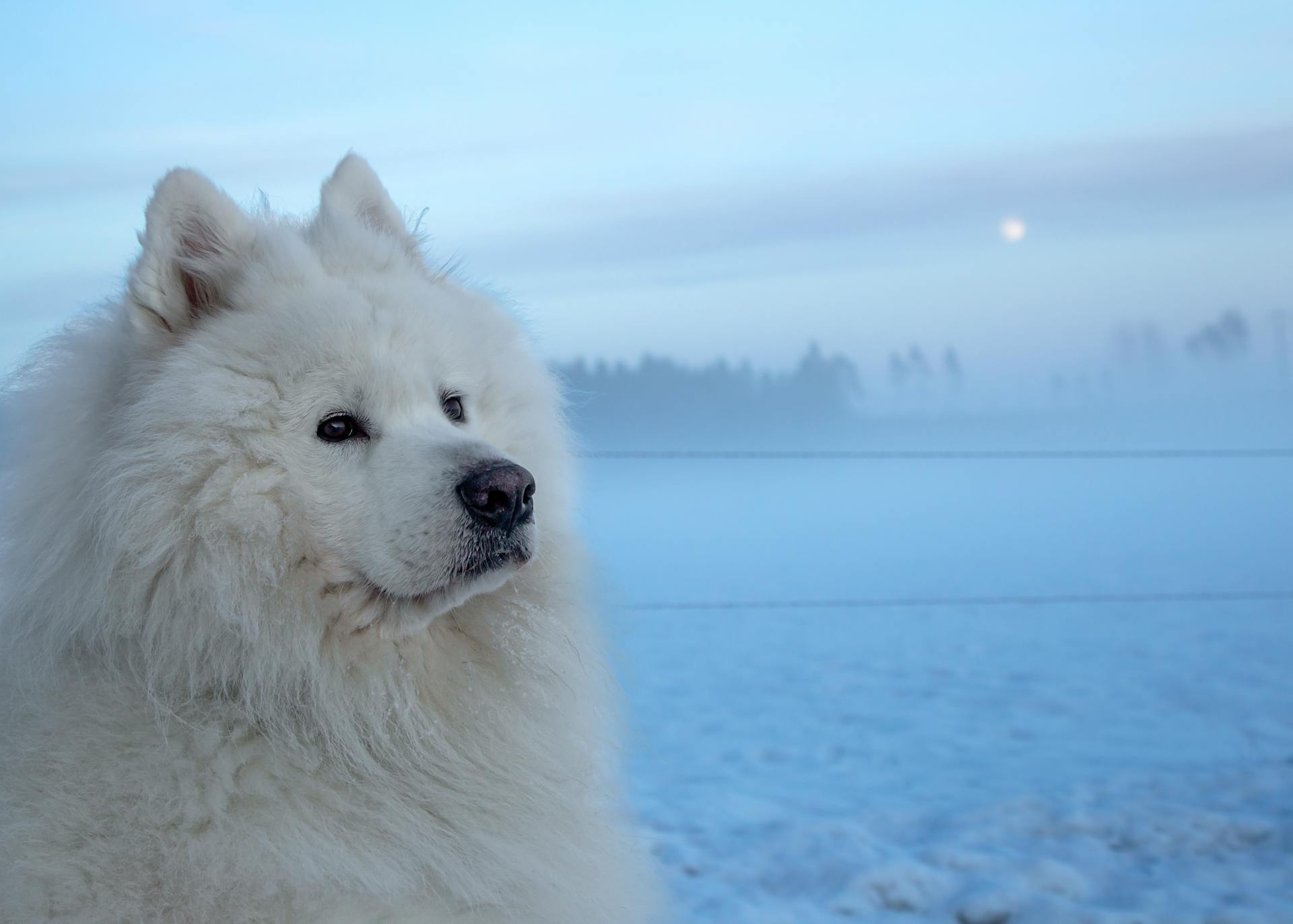
The Samoyed and the Siberian Husky are two of the most recognizable and beloved dog breeds. They share some similarities, but they also have some key differences.
Both Samoyeds and Huskies originated from cold climates and were bred to work in harsh environments. They have thick coats to keep them warm.
Samoyeds are known for their fluffy white coats, while Huskies have a thicker double coat that's more resistant to cold temperatures. Their coats require regular grooming to prevent matting.
One of the most notable differences between the two breeds is their size. Samoyeds typically weigh between 40-65 pounds and stand 19-23 inches tall, while Huskies weigh between 35-60 pounds and stand 20-23 inches tall.
Discover more: Huskies Good Apartment Dogs
Temperament and Training
The Samoyed and Husky breeds are known for their friendly and outgoing temperaments. Samoyeds, in particular, are good-natured and love to make friends, but they can be a bit mischievous if they don't receive enough attention and TLC.
Their intelligence is a double-edged sword - while it makes them quick learners, it also means they require regular mental stimulation to prevent boredom and mischief. Providing puzzle toys and interactive games is essential for keeping them intellectually stimulated.
Samoyeds are also prone to separation anxiety if left alone for long periods, so they thrive in households with multiple family members who can give them attention and affection. With proper training and socialization, however, they can become well-behaved and loving companions.
Here are some key training and temperament traits to keep in mind:
- Start training your Samoyed from a young age, including socialization, potty training, and obedience.
- Be gentle but firm, practicing positive reinforcement and trying to connect with your pup.
- Samoyeds require at least 2 hours of exercise per day, divided into several walks, play sessions, or other activities.
Temperament & Intelligence
Samoyeds are known for their delightful smiles and good-natured temperament, making them excellent family mood-booster dogs. They're whip-smart and crave attention, which can make them mischievous if left alone for too long.
Proper socialization is crucial to keep your Samoyed active, engaged, and challenged. With a pack mentality, they form deep bonds with their human families and thrive on interaction.
Samoyeds are fond of barking or using their teeth to get your attention, which can be a result of their natural instinct to grab their packmates with their mouths. This behavior is more common in untrained Sammies.
These dogs are intelligent and require regular mental stimulation to prevent boredom and mischief. A stash of puzzle toys and interactive games is a must-have for a happy and intellectually stimulated Samoyed.
Samoyeds are naturally active and require a large amount of free space due to their size. They love company, so being around a large family with kids is where they're the happiest.
Here are some key characteristics of Samoyed temperament and intelligence:
- Good-natured and friendly, but not suitable as guard dogs
- Whip-smart and crave attention
- Require regular mental stimulation to prevent boredom and mischief
- Naturally active and require a lot of space
The Biggest Differences
Some breeds are naturally more energetic than others, with some requiring up to 2 hours of exercise per day. This can be a challenge for owners with busy schedules.
The temperament of a breed can greatly impact its trainability. For example, breeds like the Golden Retriever are known for their intelligence and trainability, while breeds like the Bulldog can be more stubborn.
A breed's energy level can also affect its training needs. High-energy breeds may require more frequent and intense training sessions to keep them engaged.
You might like: Husky Dog Training
Grooming and Care
Grooming and care for Samoyeds can be a bit of a challenge, but with regular brushing, they'll be looking and feeling their best. They have a double coat that sheds quite a bit, especially during their peak shedding seasons which occur twice a year.
Brushing is a must, and it's recommended to do it at least once or twice a week to manage shedding and keep their fur healthy and shining. This will also give you quality time with your furry friend.
To prevent infections, you'll also need to brush their teeth, trim their nails, and clean their ears regularly. Regular vet checkups are also essential to ensure your Samoyed lives a long and healthy life, as they're prone to hip dysplasia, eye disorders, and cardiac disorders.
Curious to learn more? Check out: Samoyed Dog Shed
White
The white coat of a Samoyed is a beautiful thing, but it does require regular grooming to prevent matting and tangling.
Samoyeds are born with a thick, white coat that's a result of their Arctic heritage. Their eye-catching white coat is one of their most distinctive features.
To keep their coat looking its best, Samoyed owners need to brush their dog regularly, ideally daily, to prevent matting and tangling.
Consider reading: Samoyed Big White Fluffy Dog
Grooming
Grooming is a must for Samoyeds and Samuskys, as they have a double coat that's prone to shedding.
You'll need to brush them regularly, especially during peak shedding seasons, which occur twice a year.
Common brushing is super important to prevent matting and tangling of their fur.
Samoyeds and Samuskys require an intensive clean from a professional groomer every now and then to keep them looking their best.
Brushing their teeth, trimming their nails, and cleaning their ears are also essential to prevent infections.
Regular brushing can help manage shedding and serve as a bonding experience with your canine buddy.
It's a good idea to brush your Samoyed or Samusky once or twice a week to keep their fur healthy and shining.
Choosing a Breed
If you're considering bringing a Samoyed or Siberian Husky into your family, you're in for a treat. These breeds are stunning, affectionate, and family-friendly dogs.
Both Samoyeds and Huskies have their own unique personalities, but they share a common trait: they can be loyal and loving companions. Samoyeds are herding dogs at heart and have a stable white coat, while Huskies have been bred for endurance and are known for their ability to pull sleds over long distances.
On a similar theme: Dog Sledding with Huskies
If you're looking for a breed that requires more space, a Samoyed might be the better choice. They need more room to roam and exercise, which can be a challenge for city dwellers. Huskies, on the other hand, are relatively adaptable to smaller living spaces.
Samoyeds are not too fond of other animals and pets, so if you have a multi-pet household, a Husky might be a better fit. However, with the correct care and attention, both breeds can thrive in a variety of living situations.
Ultimately, the decision between a Samoyed and a Husky comes down to your personal preferences and lifestyle. Both breeds are loving and will be kind and loyal to you and your family.
Health and Costs
The initial cost of purchasing a Samoyed or Siberian Husky puppy can range from $1,000 to $3,000 USD, depending on various factors.
Owning a dog comes with ongoing expenses like food, grooming, veterinary care, training, and more.
You should also consider the initial cost as just the beginning, as owning a dog requires a long-term financial commitment.
Health and Care
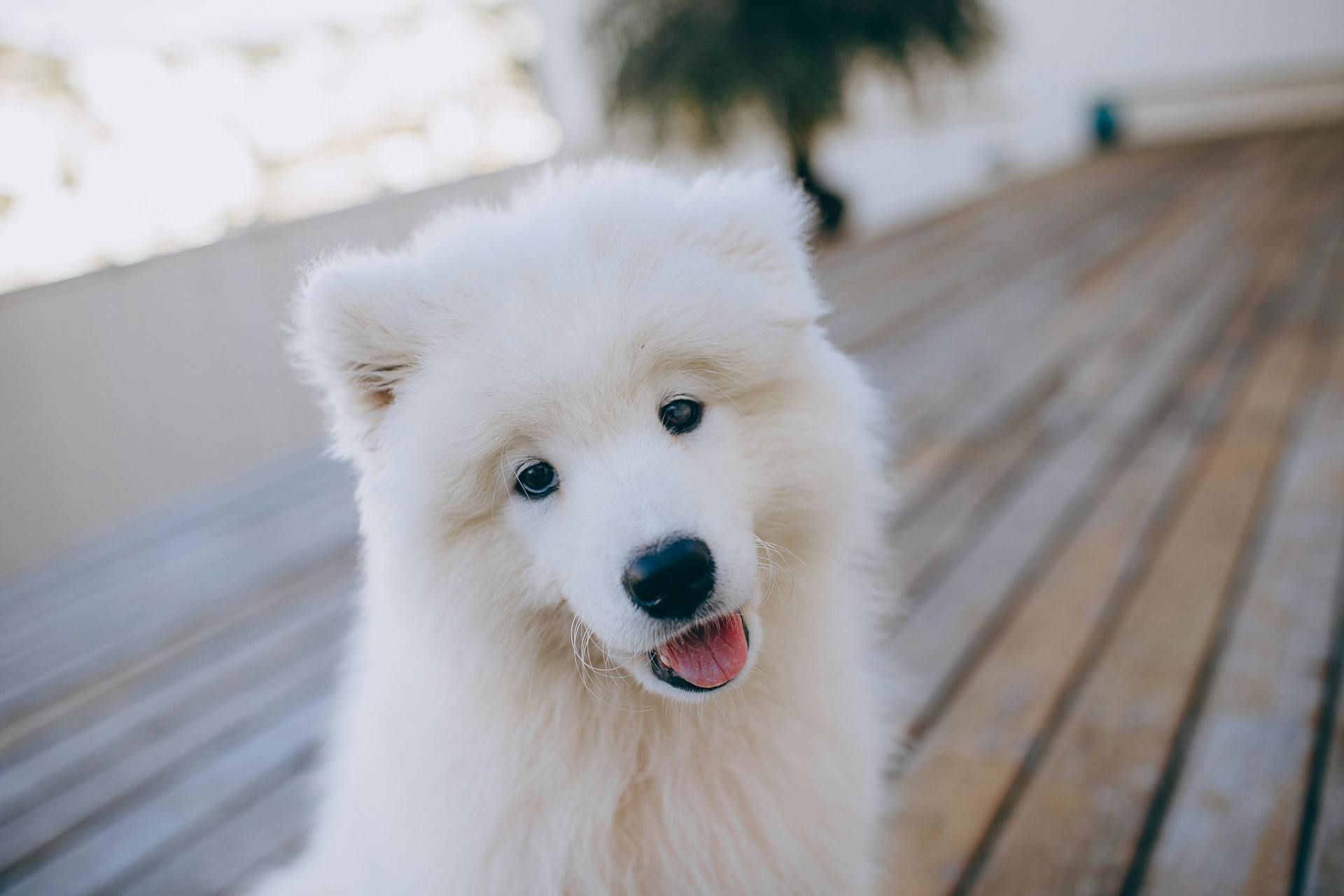
Samoyeds are generally healthy dogs with long lifespans lasting between 12 and 14 years. However, like most dog breeds, they can be prone to certain health issues due to their genetics.
Hip dysplasia, eye disorders, and cardiac disorders are some of the breed-related conditions that Samoyeds can be prone to. Regular vet checkups are essential to ensure your Samoyed lives a long and healthy life.
Daily brushing is necessary to keep your Samoyed's coat in good shape, especially during shedding seasons. This will help prevent matting and tangling of their fur.
Regular vet cleanings are crucial for proper dental care, and you should also use dental sticks and dog toothpaste to keep your Samoyed's teeth clean. Trimming your dog's nails every 3-4 weeks is also essential to prevent overgrowth.
A table summarizing the key health and care needs for Samoyeds:
Health and Conditions
As you consider the health and costs of a Samusky, it's essential to understand the potential health concerns that may arise. The good news is that the parent breeds of this mix tend to be robust, but as they age, some issues may develop.
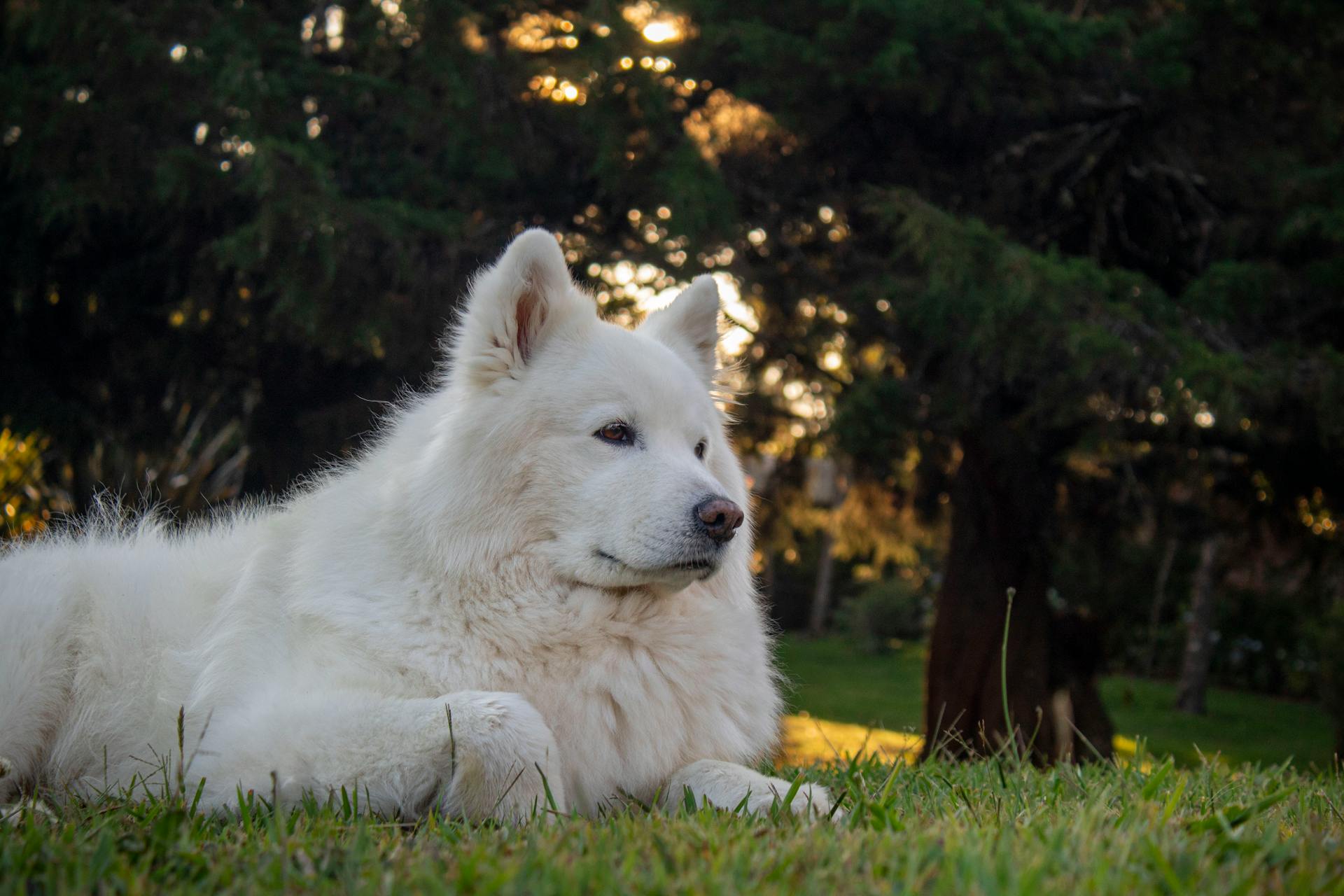
Hip dysplasia is a common problem that can affect your Samusky. This condition can lead to arthritis and mobility issues, making everyday activities more challenging.
Diabetes is another potential issue that may arise in older Samuskys. This condition requires careful management to prevent complications.
Eye defects can also impact your Samusky's quality of life. Regular eye exams can help detect any issues early on.
Here are some potential health concerns to be aware of as your Samusky ages:
One-Time Price
The initial cost of getting a Samoyed Husky can be a significant expense. The one-time price of a Samoyed Husky can range from $1,000 to $3,000 USD, depending on various factors such as the breeder's location and the dog's age, pedigree, and health.
Purchasing a puppy is just the beginning of the costs associated with owning a dog. This initial cost does not include ongoing expenses such as food, grooming, veterinary care, and training.
The price of a Samoyed Husky can vary due to demand and availability. This is why it's essential to research and understand the costs involved before making a decision.
For another approach, see: Samoyed Dog Puppy Price
Exercise and Nutrition
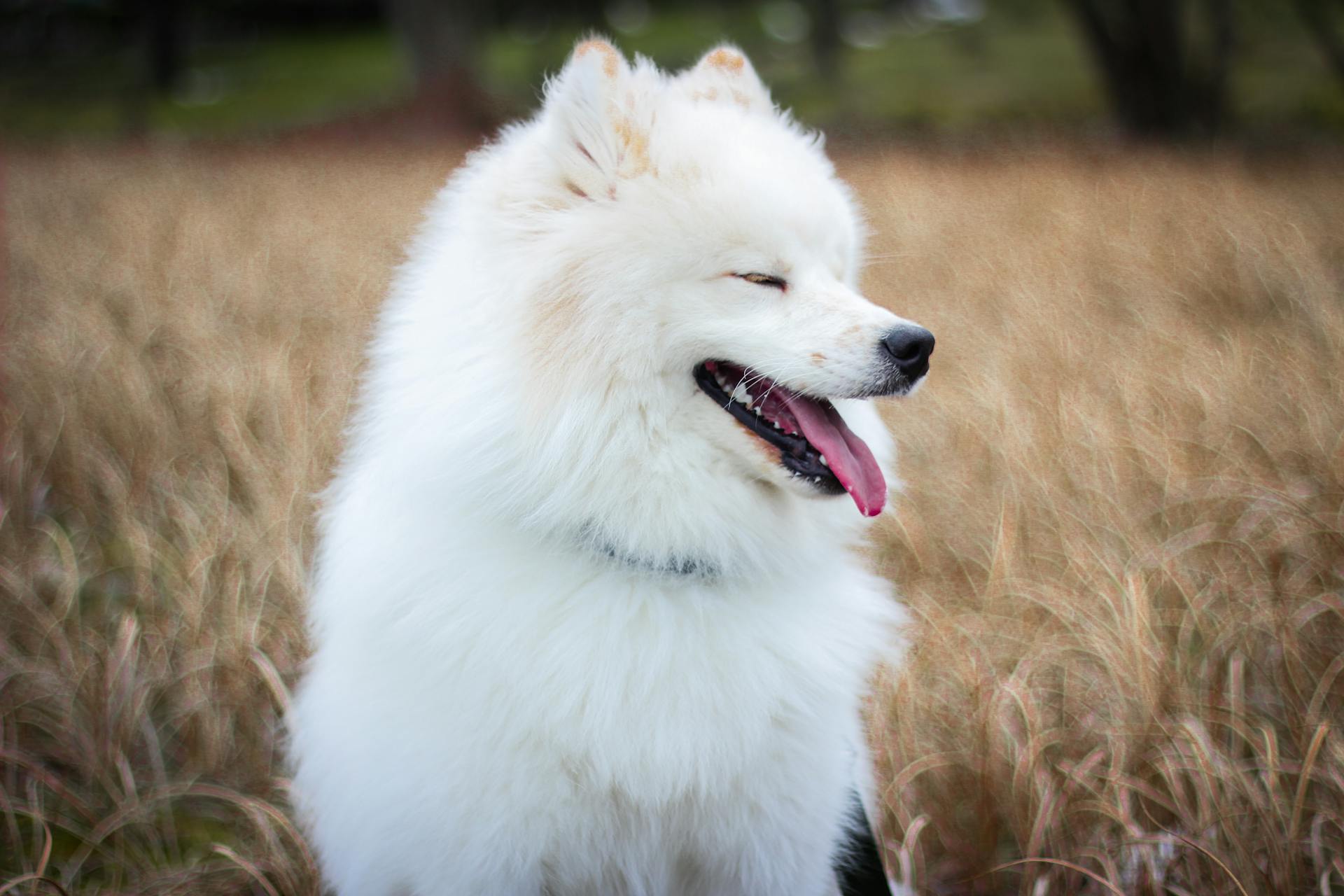
Exercise is a must for Samuskys, requiring at least two hours of physical activity each day to keep them happy and engaged.
Variety is key, so mix up activities like long walks, fetch, and agility training to keep your Samusky's mind and body stimulated.
A well-exercised Samusky is less likely to engage in destructive behaviors.
To fuel their high energy levels, Samuskys need a diet rich in high-quality protein and healthy fats, making generic dog food insufficient.
A well-balanced diet should include omega-3 fatty acids, often found in fish oils, to support brain health and coat luster.
Consult your veterinarian for a tailored feeding plan that takes into account your Samusky's age, weight, and activity level.
Exercise
Exercise is crucial for Samusky and Samoyed breeds, requiring at least two hours of physical activity per day to keep them happy and engaged.
These dogs are bundles of energy, and if you don't provide adequate exercise, they might resort to destructive behaviors. They crave new challenges and variety in their activities.
Long walks around the neighborhood, fetch in the park, and formal agility training are all great options to keep your Samusky or Samoyed physically fit and mentally stimulated. Rotate the type of activities you do to keep them engaged.
Food and Diet
Your Samusky needs a diet rich in high-quality protein and healthy fats to keep them energized and focused. They thrive on a diet that includes omega-3 fatty acids, often found in fish oils, which contribute to brain health and coat luster.
It's essential to consult your veterinarian for a tailored feeding plan that takes into account your Samusky's age, weight, and activity level. This will help you fine-tune a diet that caters to their unique needs.
A diet that's tailored to your Samusky's specific requirements will ensure they're getting the nutrients they need to stay in peak condition.
Mixed Breed
Samoyed Husky Mix puppies are nothing short of adorable furballs of joy. Their puppy phase is a fascinating combination of Siberian Husky enthusiasm and Samoyed cuddliness. These pups need active homes that can channel their high energy levels and innate intelligence into constructive activities. Otherwise, you could bear witness to destructive activities! If you're considering bringing one of these dogs home, make sure you're prepared for a demanding but rewarding puppyhood.
Owning a Mix
Owning a mixed breed dog can be a wonderful experience, but it's essential to remember that they often require more attention and exercise than their purebred counterparts.
Their high energy levels are a given, so be prepared to channel that enthusiasm into constructive activities.
They need active homes where they can run around and play, otherwise, they might get into destructive activities.
Their intelligence is also a double-edged sword - it can be a blessing and a curse if not properly channeled.
Samoyed Husky Mix puppies, for example, are adorable but demanding, requiring homes that can keep up with their Siberian Husky enthusiasm and Samoyed cuddliness.
Their puppy phase is a whirlwind of energy and curiosity, and it's crucial to be prepared for the challenges that come with it.
3 Little-Known Facts About the Mix
Mixed breed dogs have a unique genetic makeup that can make them healthier than purebred dogs. This is due to the fact that they have a more diverse gene pool, which reduces the likelihood of inherited health problems.
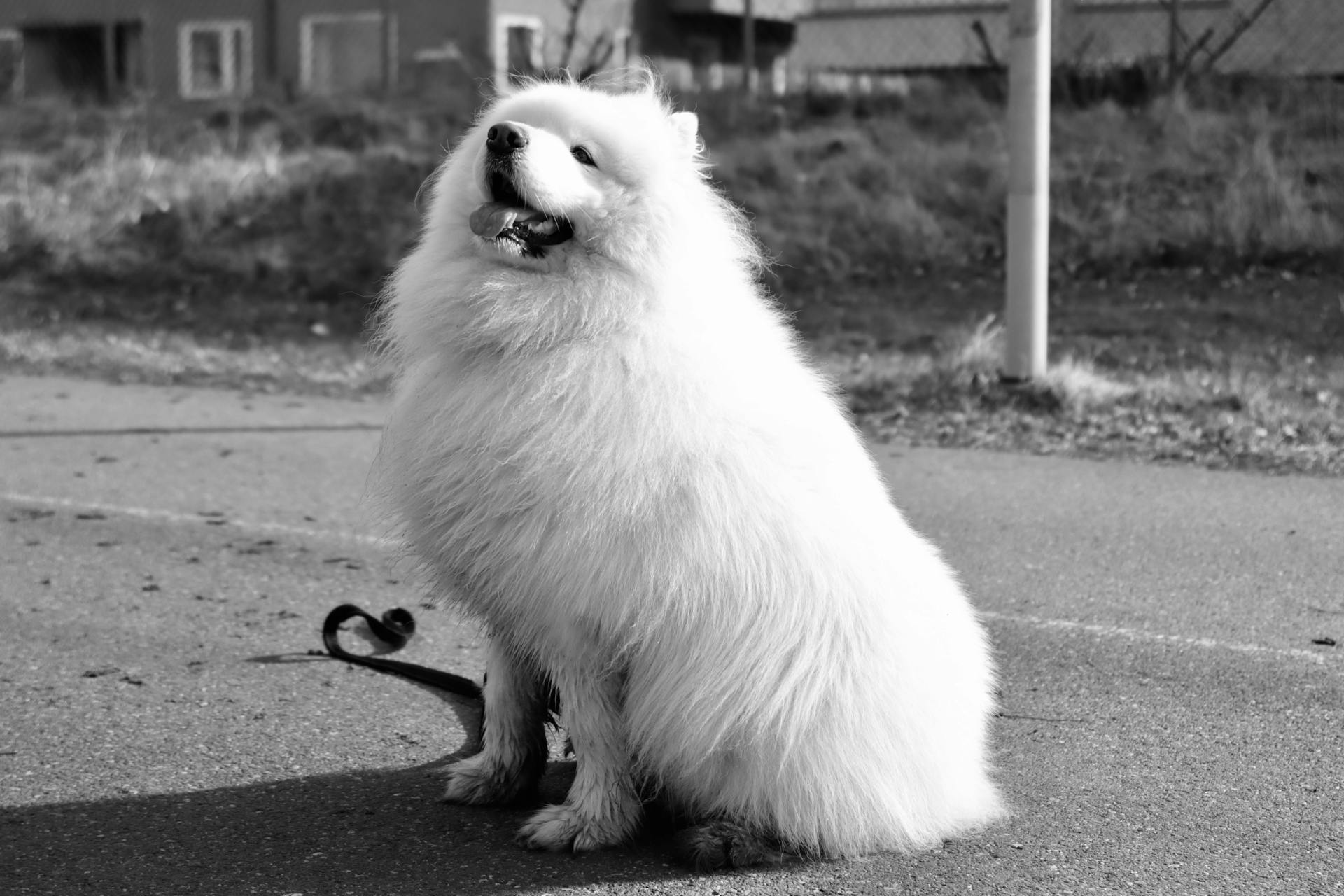
One little-known fact about mixed breed dogs is that they are often less prone to hip dysplasia. This is because they inherit a more balanced set of genes from their mixed ancestry, which can help to prevent this common joint issue.
Many mixed breed dogs are also highly intelligent and trainable. This is because they often inherit the intelligence and trainability traits from their parent breeds, which can make them highly responsive to commands and training.
A study found that mixed breed dogs have a lower risk of certain cancers, such as osteosarcoma and lymphoma. This is likely due to the fact that they have a more diverse genetic makeup, which can help to prevent these types of cancer.
Frequently Asked Questions
Are Samoyeds vocal like huskies?
Samoyeds are known for their barking, unlike Siberian Huskies which are more prone to howling. If you're considering a Samoyed as a pet, be prepared for a vocal companion.
What are the weaknesses of Samoyeds?
Samoyeds can be prone to destructive behavior, excessive barking, and heavy shedding, while also requiring regular exercise and mental stimulation to prevent stubbornness and rowdiness. Proper care and attention can help mitigate these weaknesses, but they are essential considerations for potential owners.
Sources
- https://be.chewy.com/dog-breeds/compare/husky-vs-samoyed/
- https://vetplayas.com/samoyed-vs-husky-the-differences-with-pictures/
- https://universeforpets.medium.com/samoyed-husky-a-beautiful-and-intelligent-breed-for-your-home-5c0437015f38
- https://www.dogster.com/dog-breeds/samoyed-husky-mix
- https://www.hepper.com/samoyed-vs-husky/
Featured Images: pexels.com


